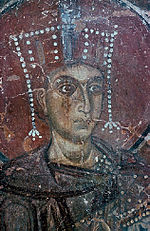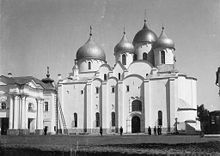Cathedral of St. Sophia, Novgorod
| Cathedral of St. Sophia Софийский собор (in Russian) | ||
|---|---|---|
Year consecrated 1050 or 1052 | | |
| Location | ||
| Location | Veliky Novgorod, Russia | |
| Geographic coordinates | 58°31′18″N 31°16′34″E / 58.52167°N 31.27611°E | |
| Architecture | ||
| Type | Church | |
| Groundbreaking | 1045 | |
| Completed | 1050 | |
| Specifications | ||
| Height (max) | 38 metres (125 ft) | |
| Dome(s) | 5 | |
| Official name: Historic Monuments of Novgorod and Surroundings | ||
| Type | Cultural | |
| Criteria | ii, iv, vi | |
| Designated | 1992 (16th session) | |
| Reference no. | 604 | |
| State Party | Russia | |
| Region | Eastern Europe | |
The Cathedral of St. Sophia, the Holy Wisdom of God (
History
The 38-metre-high, five-domed, stone cathedral was built by
The main, golden cupola, was gilded by Archbishop
The cupolas are thought to have acquired their present helmet-like shape in the 1150s, when the cathedral was restored after a fire. The interior was painted in 1108 at the behest of Bishop
From the 12th to the 15th century, the cathedral was a ceremonial and spiritual centre of the Novgorod Republic, which sprawled from the Baltic Sea to the Ural Mountains, and came to symbolize the city itself, with chronicle references to the Novgordians being willing "to lay down their heads for Holy Wisdom" or "to die honorably for Holy Wisdom."[6] When one prince angered them, they told him "we have no prince, only God, the Truth, and Holy Wisdom."[7] On another occasion, they made the cathedral the symbol of the city itself, saying "Where Holy Wisdom is, there is Novgorod."[8]

The House of Holy Wisdom (Дом святой Софии/Dom svyatoy Sofii) was one of the largest landowners in the Novgorod Land. Its possessions were spread across all parts of Novgorod land and outside of it. In the 16th century the House had its own court in Moscow and by the second half of 17th century it also owned 41 monasteries with their land and peasants. The bishop (later, archbishop) headed the House of Holy Wisdom. He was assisted by the head of the chancellery (d'yak) and treasurer and about 100 other staff who included scribes, bookbinders, icon painters and silversmiths.[9]
The cathedral has long been the city's great necropolis, the burial place of 47 people of prominence in the city's history, including several princes and posadniks and 32 bishops, archbishops, and metropolitans of Novgorod. The first burial there was Prince Vladimir himself in 1052. The first bishop was Luka Zhidiata in 1060. The last burial in the cathedral was Metropolitan Gurii in 1912. Most of the burials are below the floor in the Martirievskaia Porch, on the south side of the cathedral, named for Bishop Martirii (1193–1199). Later burials took place (again below the floor) in the Pretechenskaia Papter' on the north side of the cathedral. Today, there are several burials in the main body of the church. The sarcophagi of Prince Vladimir and Princess Anna overlook the Martirievskaia Porch; Archbishop Ilya (also known as Ioann) (1165–1186) is buried in the northwestern corner of the main body of the church, next to the Pretechenskaia Porch. Bishop Nikita lies in a glass-covered sarcaphogus between the chapels of the Nativity of the Mother of God and Sts. Ioakim and Anne and the sarcophagus is opened on his feast days (January 30, the day of his death and April 30/May 13, the day of the "uncovering of his relics," i.e., when his tomb was opened in 1558) so the faithful can venerate his relics. Two other princes also lie in the main body of the cathedral and in the Chapel of the Nativity of the Mother of God.[10]



The cathedral was looted by Ivan the Terrible in the 1570s but restored by Archbishop Leonid (1572–1575). He built the Tsar's Pew which stands just inside the south entrance of the main body of the cathedral near the Martirievskii Porch. Leonid also had several large chandeliers hung in the cathedral, but only one of them survives.[5]
Beginning in the eighteenth century, the archbishops or metropolitans of Novgorod lived in St. Petersburg (they were known as archbishops or metropolitans of Novgorod and St. Petersburg). Thus, while Novgorod technically still had a prelate, he was not often active in the city itself, and the church in the city was administered by a vicar bishop for much of the time. Twelve metropolitans of Novgorod and St. Petersburg (or Leningrad) are buried in the Alexander Nevsky Lavra in St. Petersburg, rather than in the Cathedral of Holy Wisdom.
During the Nazi occupation of Novgorod, the Kremlin was heavily damaged from the battles and from the Nazi abuse. However, the cathedral itself survived. The large cross on the main dome (which has a metal bird attached to it, perhaps symbolic of the Holy Spirit in the form of a dove) was removed by Spanish infantry. For over 60 years it resided in the Madrid's Military Engineering Academy Museum, until November 16, 2004, when it was handed over back to the Russian Orthodox Church by the Spanish brothers Miguel Ángel and Fernando Garrido Polonio who discovered the Cross in a military camp in Madrid. The domes were heavily damaged in the war, and the large Christ Pantocrator in the dome was ruined. According to legend, the painters painted him with a clenched fist. The archbishop told them to repaint Christ with an open palm, and when they returned the next morning, the hand was miraculously clenched again. After repeated efforts, a voice from the dome is said to have told the archbishop to leave the painting alone for as long as Christ's fist remained closed, he would hold the fate of Novgorod in his hand.[11]
During the Soviet period, the cathedral was a museum. It was returned to the Russian Orthodox Church in 1991. An inscription on the north wall of the west entrance attests to its rededication by Bishop Lev and
Features

Novgorod's St. Sophia was the first Slavic church in which local divergences from Byzantine pattern were made so evident. With its austere walls, narrow windows, the church is redolent of Romanesque architecture of Western Europe, rather than of Greek churches built at that time.
The Novgorod cathedral also differs strikingly from its
Icons
The oldest icon in the cathedral is probably the Icon of the

Gates
Three famous sets of gates adorned the cathedral over the centuries; they are known as the Korsun, Vasilii, and Sigtuna (or Płock, or Magdeburg) Gates. The Korsun Gates hang at the western entrance to the Chapel of the Nativity of the Mother of God at the southeast corner of the cathedral. They were said to have been brought to Novgorod by Bishop Ioakim Korsunianin, whose name indicates ties to
The gates were acquired by the Novgorodians most probably in the end of the 15th century, probably by Archbishop Evfimii II, who loved Western art (as can be seen in the Gothic style incorporated into the Palace of Facets) or—according to another theory—in the first half of the 15th century
Pigeon
A figure of pigeon—the symbol of the Holy Spirit—crowns the cross on the main dome of the cathedral. According to a local legend, a live pigeon sitting on the dome froze out of terror seeing the Massacre of Novgorod. In the 18th century the cathedral's treasury included a gold-plated silver pigeon. The dome and the figure were destroyed during the Nazi occupation of Novgorod and then restored after the war. The original figure was returned to Novgorod in 2005 by former members of the Blue Division who fought in Novgorod.[16]
See also
- Saint Sophia Cathedral, Kyiv
- Saint Sophia Cathedral in Polotsk
- Hagia Sophia
References
- ^ A. N. Nasonov, ed., Novgorodskaia Pervaia Letopis Starshego i mladshego izvodov (Moscow and Leningrad: AN SSSR, 1950), 16,181.
- ^ T. Iu. (Tatiana Iur’evna) Tsarevskaia, St. Sofia’s Cathedral in Novgorod, D. G. Fedosov, trans. (Moscow: Severnyi Palomnik, 2005). This is an English translation of Sofiiskii sobor v Novgorode. 2nd ed. (Moscow: Severnyi palomnik, 2005). The Sofia First Chronicle dates the consecration to 1050, the Novgorodian Third Chronicle to 1052. See Sofiiskii Sobor v Velikom Novgorode: Arkhitektura i istoriia, online at http://www.russiancity.ru/text/nov01.htm
- ^ See his biography online at "Великий Новгород.ру - Персоналии". Archived from the original on 2007-03-13. Retrieved 2007-08-02.
- ^ N. Savushkina, “Biblioteka Sofiiskogo Sobora,” Sofia, No. 1 (2004).
- ^ a b c d Tsarevskaia, St. Sofia’s Cathedral in Novgorod.
- ^ A. N. Nasonov, ed. Novgorodskaia Pervaia Letopis, 82, 310
- ^ Nasonov, ed. Novgorodskaia Pervaia Letopis, 89, 320-21; Michael C. Paul, “The Iaroslavichi and the Novgorodian Veche,” Russian History/ Histoire Russe 31, No. 1-2 (Spring-Summer 2004):53.
- ^ Sofiiskaia Pervaia Letopis, Volume 6 of Polnoe Sobranie Russkikh Letopisei, p. 251.
- ISBN 978-5981872365.
- ^ Valentin Lavrent'evich Ianin, Nekropol Novgorodskogo Sofiiskogo sobora: tserkovnaia traditsiia i istoricheskaia kritika (Moscow: Nauka, 1988); Tsarevskaia, St. Sofia’s Cathedral in Novgorod.
- ^ Tsarevskaia, St. Sofia’s Cathedral in Novgorod. See also "Legenda o Spasa Vederzhitele so szhatoiu rukoi," (Легенда о Спасе Вседержителе со сжатою рукой = The Legend of the Almighty Savior with the Clenched Hand",) available online at http://bibliotekar.ru/novgorod13.htm
- ^ Makarii (Veretennikov, Petr Ivanovich; Archimandrite), “Vasil’evskie Vrata.” In Makarievskaia Chteniia. Russkaia Kul’tura XVI veka – epoka Mitropolita Makariia. Materialy X Rossiiskoi nauchnoi konferentsii posviashchenoi Pamiati Sviatitelia Makariia. Vypusk 10. (Mozhaisk: Terra, 2003): 111-119.
- ^ Borkowski Robert,Multimedialna Historia Płocka, E-MOTION Sp. z o.o.
- ISBN 83-221-0307-7, page 142.
- ^ Jadwiga Irena Daniec, The Message of Faith and Symbol in European Medieval Bronze Church Doors (Danbury, CT: Rutledge Books, 1999); Andrzej Poppe, “K istorii romanskikh dverei Sofii Novgorodskoi.” In G. K. Vagner and D. S. Likhachev. Srednevekovaia Rus’ (Moscow: Nauka, 1976): 191-200; Tsarevskaia, St. Sofia’s Cathedral in Novgorod; Idem, Magdeburgskie vrata Novgorodskoto Sofiiskogo Sobora (Moscow: Severanyi Palomnik, 2001); A. N. (Anna Nikolaevna) Trifonova, “Bronzovye dveri Sofiiskogo Sobora v Novgorode.” Novgorod i Novgorodskaia Zemlia: Istoriia i Arkheologiia 9 (1995): 230-242.
- ISBN 978-5981872365.
